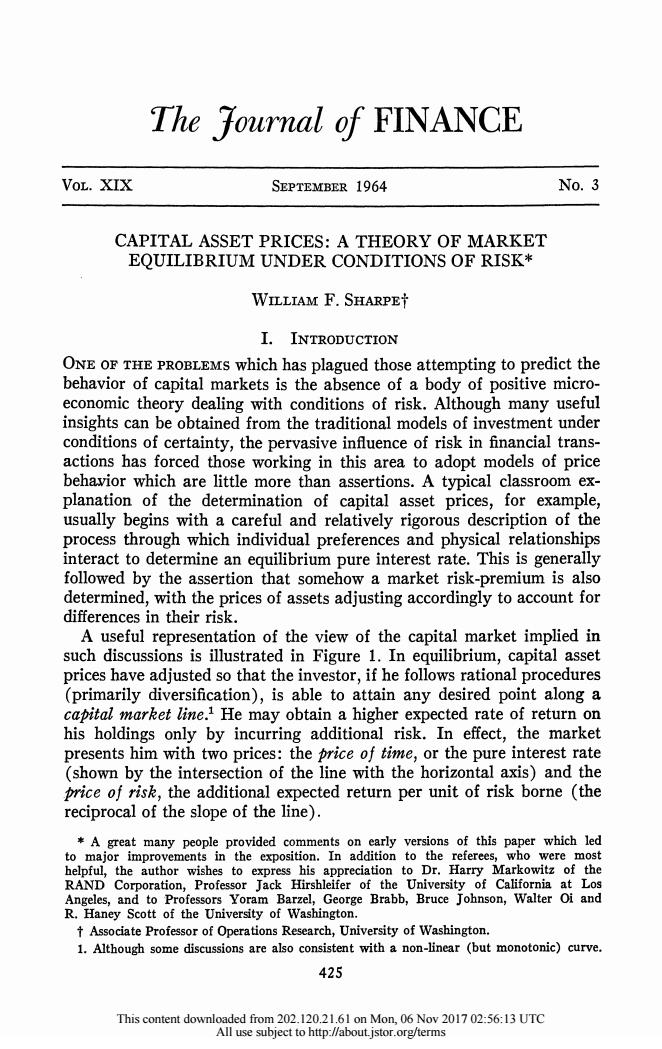正在加载图片...

The Fournal of FINANCE VoL.XIX SEPTEMBER 1964 No.3 CAPITAL ASSET PRICES:A THEORY OF MARKET EQUILIBRIUM UNDER CONDITIONS OF RISK* WILLIAM F.SHARPE I.INTRODUCTION ONE OF THE PROBLEMs which has plagued those attempting to predict the behavior of capital markets is the absence of a body of positive micro- economic theory dealing with conditions of risk.Although many useful insights can be obtained from the traditional models of investment under conditions of certainty,the pervasive influence of risk in financial trans- actions has forced those working in this area to adopt models of price behavior which are little more than assertions.A typical classroom ex- planation of the determination of capital asset prices,for example, usually begins with a careful and relatively rigorous description of the process through which individual preferences and physical relationships interact to determine an equilibrium pure interest rate.This is generally followed by the assertion that somehow a market risk-premium is also determined,with the prices of assets adjusting accordingly to account for differences in their risk. A useful representation of the view of the capital market implied in such discussions is illustrated in Figure 1.In equilibrium,capital asset prices have adjusted so that the investor,if he follows rational procedures (primarily diversification),is able to attain any desired point along a capital market line.1 He may obtain a higher expected rate of return on his holdings only by incurring additional risk.In effect,the market presents him with two prices:the price of time,or the pure interest rate (shown by the intersection of the line with the horizontal axis)and the price of risk,the additional expected return per unit of risk borne (the reciprocal of the slope of the line). *A great many people provided comments on early versions of this paper which led to major improvements in the exposition.In addition to the referees,who were most helpful,the author wishes to express his appreciation to Dr.Harry Markowitz of the RAND Corporation,Professor Jack Hirshleifer of the University of California at Los Angeles,and to Professors Yoram Barzel,George Brabb,Bruce Johnson,Walter Oi and R.Haney Scott of the University of Washington. Associate Professor of Operations Research,University of Washington. 1.Although some discussions are also consistent with a non-linear (but monotonic)curve. 425 This content downloaded from 202.120.21.61 on Mon,06 Nov 2017 02:56:13 UTC All use subject to http://about.istor.org/termsThe journal of FINANCE VOL. XIX SEPTEMBER 1964 No. 3 CAPITAL ASSET PRICES: A THEORY OF MARKET EQUILIBRIUM UNDER CONDITIONS OF RISK* WILLIAM F. SHARPEt I. INTRODUCTION ONE OF THE PROBLEMS which has plagued those attempting to predict the behavior of capital markets is the absence of a body of positive micro- economic theory dealing with conditions of risk. Although many useful insights can be obtained from the traditional models of investment under conditions of certainty, the pervasive influence of risk in financial trans- actions has forced those working in this area to adopt models of price behavior which are little more than assertions. A typical classroom ex- planation of the determination of capital asset prices, for example, usually begins with a careful and relatively rigorous description of the process through which individual preferences and physical relationships interact to determine an equilibrium pure interest rate. This is generally followed by the assertion that somehow a market risk-premium is also determined, with the prices of assets adjusting accordingly to account for differences in their risk. A useful representation of the view of the capital market implied in such discussions is illustrated in Figure 1. In equilibrium, capital asset prices have adjusted so that the investor, if he follows rational procedures (primarily diversification), is able to attain any desired point along a capital market line.' He may obtain a higher expected rate of return on his holdings only by incurring additional risk. In effect, the market presents him with two prices: the price of time, or the pure interest rate (shown by the intersection of the line with the horizontal axis) and the price of risk, the additional expected return per unit of risk borne (the reciprocal of the slope of the line). * A great many people provided comments on early versions of this paper which led to major improvements in the exposition. In addition to the referees, who were most helpful, the author wishes to express his appreciation to Dr. Harry Markowitz of the RAND Corporation, Professor Jack Hirshleifer of the University of California at Los Angeles, and to Professors Yoram Barzel, George Brabb, Bruce Johnson, Walter Oi and R. Haney Scott of the University of Washington. t Associate Professor of Operations Research, University of Washington. 1. Although some discussions are also consistent with a non-linear (but monotonic) curve. 425 This content downloaded from 202.120.21.61 on Mon, 06 Nov 2017 02:56:13 UTC All use subject to http://about.jstor.org/terms